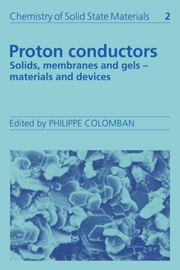Book contents
- Frontmatter
- Contents
- List of contributors
- Preface
- Symbols
- I HYDROGEN BOND AND PROTONIC SPECIES
- II MATERIALS: PREPARATION, STRUCTURES AND PROPERTIES
- III PROTON DYNAMICS AND CHARGE TRANSPORT
- IV PROTON DIFFUSION MECHANISMS
- 29 Mobility in hydrogen-containing oxide bronzes: the atomic-level detail
- 30 Conductivity mechanisms and models in anhydrous protonic conductors
- 31 Conduction mechanisms in materials with volatile molecules
- V DEVICES
- Index
30 - Conductivity mechanisms and models in anhydrous protonic conductors
Published online by Cambridge University Press: 04 May 2010
- Frontmatter
- Contents
- List of contributors
- Preface
- Symbols
- I HYDROGEN BOND AND PROTONIC SPECIES
- II MATERIALS: PREPARATION, STRUCTURES AND PROPERTIES
- III PROTON DYNAMICS AND CHARGE TRANSPORT
- IV PROTON DIFFUSION MECHANISMS
- 29 Mobility in hydrogen-containing oxide bronzes: the atomic-level detail
- 30 Conductivity mechanisms and models in anhydrous protonic conductors
- 31 Conduction mechanisms in materials with volatile molecules
- V DEVICES
- Index
Summary
During the past ten years, there have been numerous efforts to give an adequate description of superionic conduction, but they concern exclusively non-protonic conductors. In these compounds, neither tunnelling mechanisms nor oriented hydrogen bonds have been considered. However, in certain anhydrous compounds containing oxonium and ammonium ions, for instance, protonic conduction can also be interpreted in terms of such ‘non-protonic’ models. We shall start by giving a review of general models before discussing the problems particular to protonic conduction.
Theoretical interpretations of superionic conduction
Three main types of theoretical description can be distinguished, (i) Models derived from liquid or highly disordered solid electrolytes such as glasses or polymers. (ii) Continuous models based on solutions of Langevin's equation. These models can be improved by taking into account cooperative effects corresponding to liquid models (Brownian or stochastic particles) fitted to a periodic medium, (iii) Hopping models or lattice gas models, initially developed for phase transitions. They can consider dimensions higher than one and are closely associated with studies on reorientational motion in plastic crystals and on surface melting such as occurs with rare gas layers on graphite.
Fig. 30.1 shows that for the diffusion of a particle, several cases can be distinguished depending on the relative magnitudes of residence time τ0 on site A and of time of flight τ1 to site B. Existence of (polyatomic) protonic species establishing an oriented bond implies a necessary correlation between translational and rotational motions during a diffusive jump.
- Type
- Chapter
- Information
- Proton ConductorsSolids, Membranes and Gels - Materials and Devices, pp. 457 - 473Publisher: Cambridge University PressPrint publication year: 1992
- 1
- Cited by



